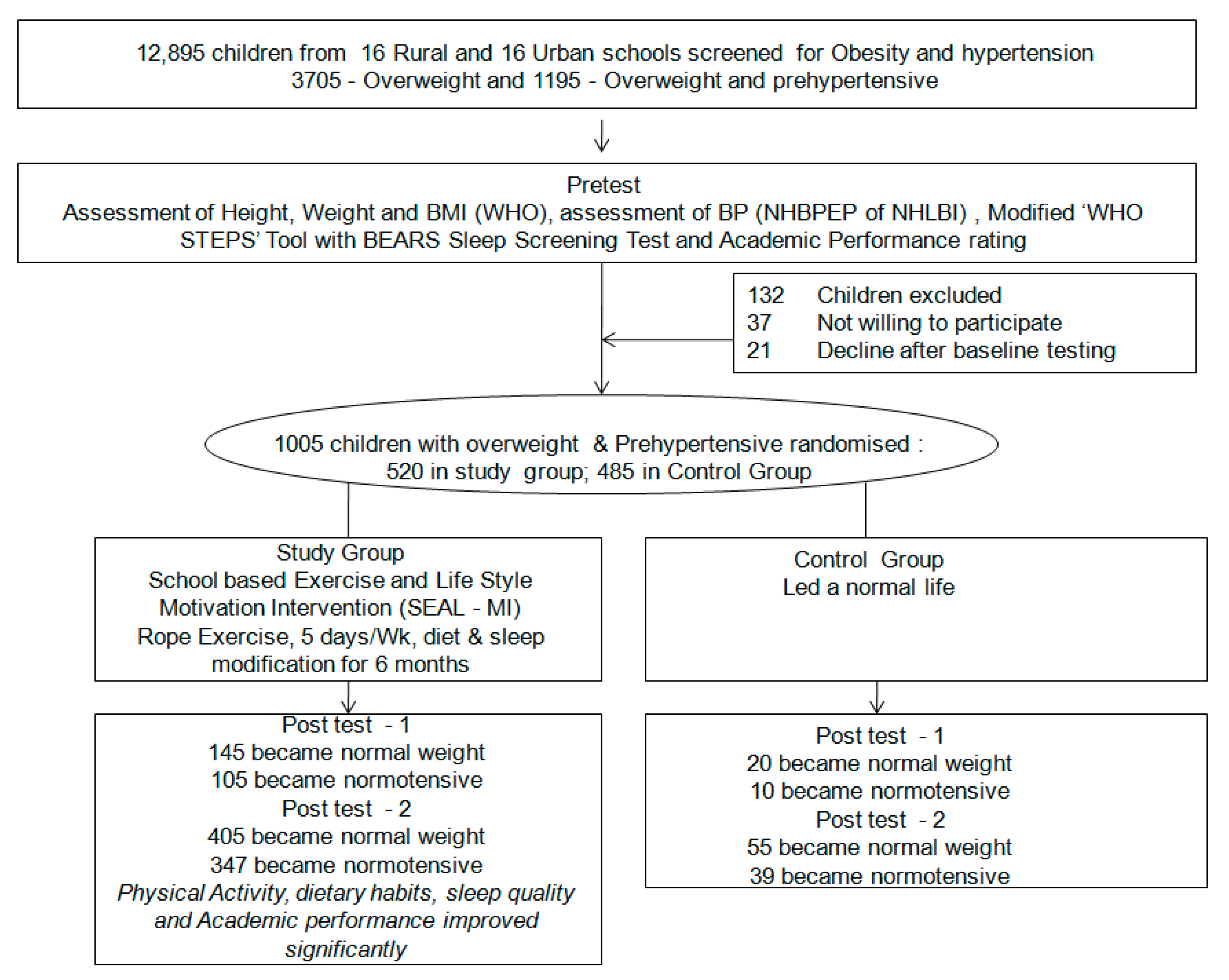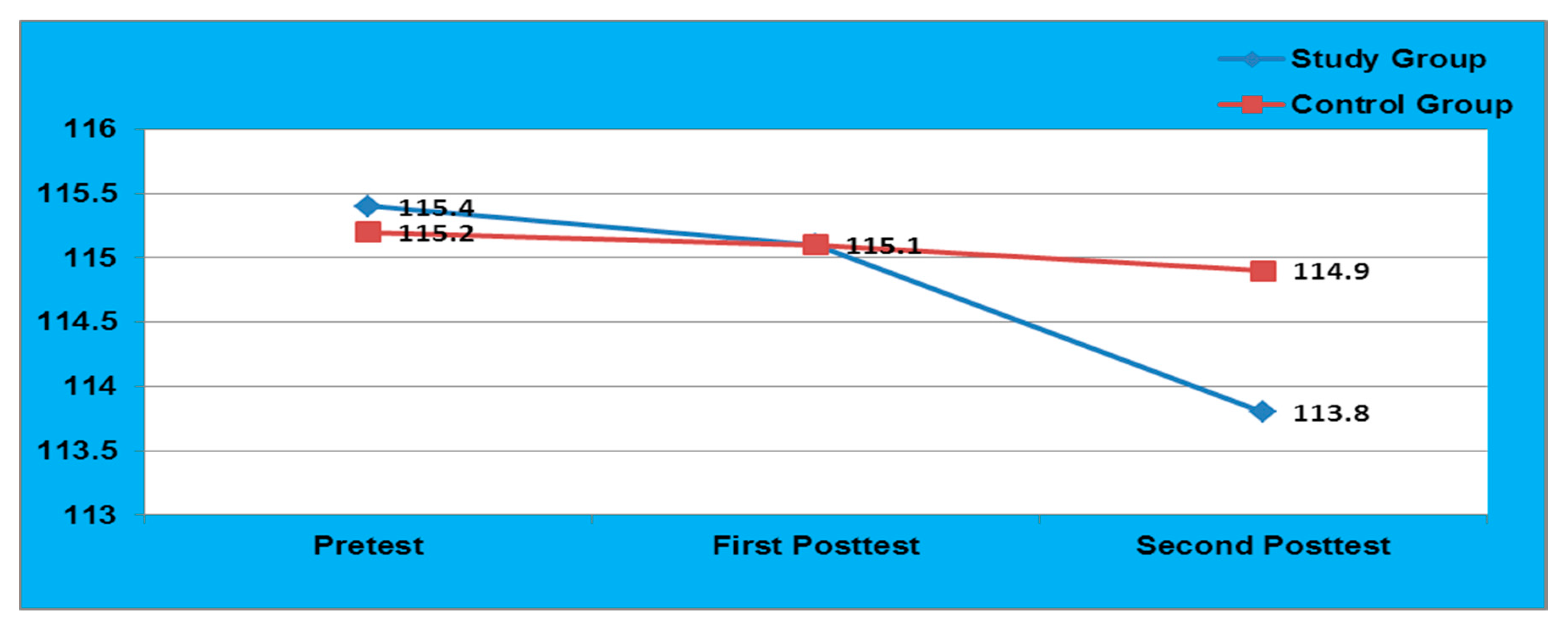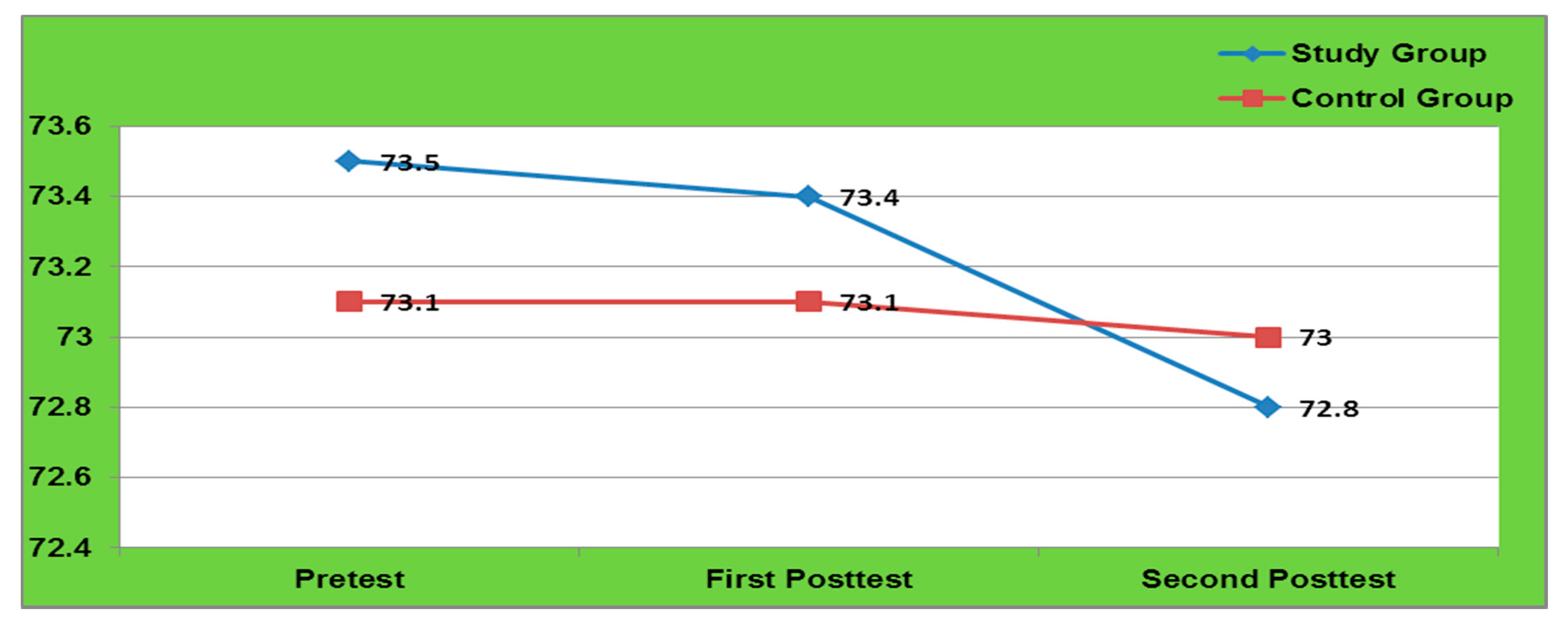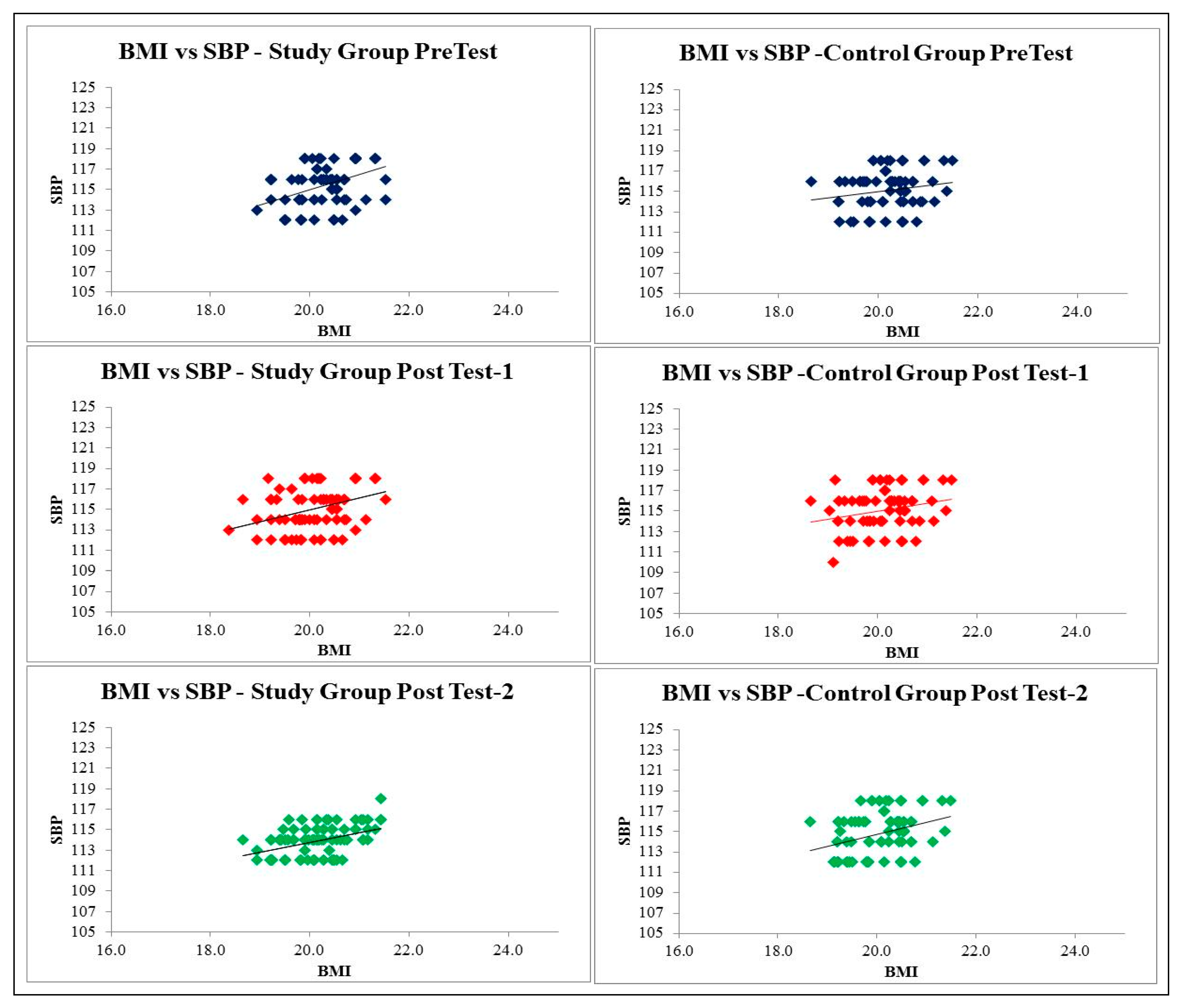School-Based Exercise and Life Style Motivation Intervention (SEAL.MI) on Adolescent’s Cardiovascular Risk Factors and Academic Performance: Catch Them Young
Abstract
1. Introduction
2. Methods
2.1. Design
2.2. Population and Setting
2.3. Sample Size and Sampling Process
2.4. Tools/Instruments
- B.P. less than the 90th percentile is normal.
- B.P. between the 90th and 95th percentile is prehypertension. In adolescents, B.P. equal to or exceeding 120/80 mmHg is prehypertension, even if this figure is less than the 90th percentile.
- B.P. greater than the 95th percentile may be hypertension.
2.5. Intervention
2.6. Data Collection Tools/Instruments
2.7. Ethical Consideration
2.8. Statistical Analysis
3. Results
4. Discussion
5. Conclusions
6. Implications
Author Contributions
Funding
Institutional Review Board Statement
Informed Consent Statement
Data Availability Statement
Acknowledgments
Conflicts of Interest
References
- NCD Risk Factor Collaboration. Worldwide trends in body-mass index, underweight, overweight, and obesity from 1975 to 2016: A pooled analysis of 2416 population-based measurement studies in 128.9 million children, adolescents, and adults. Lancet 2017, 390, 2627–2642. [Google Scholar] [CrossRef]
- World Health Organization. Obesity and Overweight. Available online: http://www.who.int/news-room/fact-sheets/detail/obesity-and-overweight (accessed on 1 October 2021).
- Kelly, L.A.; Loza, A.; Lin, X.; Schroeder, E.T.; Hughes, A.; Kirk, A.; Knowles, A.-M. The effect of a home-based strength training program on type 2 diabetes risk in obese Latino boys. J. Pediatr. Endocrinol. Metab. 2015, 28, 315–322. [Google Scholar] [CrossRef] [PubMed]
- Strasser, B.; Arvandi, M.; Pasha, E.; Haley, A.; Stanforth, P.; Tanaka, H. Abdominal obesity is associated with arterial stiffness in middle-aged adults. Nutr. Metab. Cardiovasc. Dis. 2015, 25, 495–502. [Google Scholar] [CrossRef] [PubMed]
- Jansen, M.A.; Uiterwaal, C.S.; Visseren, F.L.; van der Ent, C.K.; Grobbee, D.E.; Dalmeijer, G.W. Abdominal fat and blood pressure in healthy young children. J. Hypertens. 2016, 34, 1796–1803. [Google Scholar] [CrossRef] [PubMed]
- Saijo, Y.; Kiyota, N.; Kawasaki, Y.; Miyazaki, Y.; Kashimura, J.; Fukuda, M.; Kishi, R. Relationship between C-reactive protein and visceral adipose tissue in healthy Japanese subjects. Diabetes Obes. Metab. 2004, 6, 249–258. [Google Scholar] [CrossRef] [PubMed]
- Calzada, P.J.; Anderson-Worts, P. The obesity epidemic: Are minority individuals equally affected? Prim. Care Clin. Off. Pr. 2009, 36, 307–317. [Google Scholar] [CrossRef] [PubMed]
- Aguirre-Pérez, D.M.; Otero-Ojeda, G.A.; Pliego-Rivero, F.B.; Ferreira-Martínez, A.A. Relationship of working memory and EEG to academic performance: A study among high school students. Int. J. Neurosci. 2007, 117, 869–882. [Google Scholar] [CrossRef] [PubMed]
- Kim, J.-H.; So, W.-Y. Association between overweight/obesity and academic Performance in South Korean adolescents. Central Eur. J. Public Health 2013, 21, 179–183. [Google Scholar] [CrossRef] [PubMed]
- Gustafson, D.; Lissner, L.; Bengtsson, C.; Bjorkelund, C.; Skoog, I. A 24-year follow-up of body mass index and cerebral atrophy. Neurology 2004, 63, 1876–1881. [Google Scholar] [CrossRef] [PubMed]
- Goodman, E.; Whitaker, R.C. A prospective study of the role of depression in the development and persistence of adolescent obesity. Pediatrics 2002, 110, 497–504. [Google Scholar] [CrossRef] [PubMed]
- World Health Organization. WHO STEPS Surveillance Manual. The WHO STEP Wise Approach to Chronic Disease Risk Factor Surveillance. Geneva: WHO. 2005. Available online: https://apps.who.int/iris/handle/10665/43376 (accessed on 27 September 2021).
- CDC. Data Table of BMI-for-Age Charts. Body Mass Index for Age Tables, Adolescents Ages 2–20 Years Selected Percentiles. 2000. Available online: https://www.cdc.gov/nccdphp/dnpa/growthcharts/training/modules/module1/text/module1print.pdf (accessed on 15 July 2021).
- National High, B.P. Education Program (NHBPEP) in 2004: National Institutes of Health in the United States Established the National Center for Complementary and Integrative Health. Available online: www.nccih.nih.gov (accessed on 13 July 2021).
- Falkner, B.; Daniels, S.R.; Flynn, J.T.; Gidding, S.; Green, L.A.; Ingelfinger, J.R.; Lauer, R.M.; Morgenstern, B.Z.; Portman, R.J.; Prineas, R.J.; et al. The 4th report on the diagnosis, evaluation, and treatment of high blood pressure in adolescents and adolescents. Pediatrics 2004, 114 (Suppl. 2), 555–576. [Google Scholar]
- Evensen, E.; Wilsgaard, T.; Furberg, A.-S.; Skeie, G. Tracking of overweight and obesity from early childhood to adolescence in a population-based cohort-the Tromsø Study, Fit Futures. BMC Pediatr. 2016, 16, 64. [Google Scholar] [CrossRef]
- Gopalakrishnan, H.; Jamalnasser, F.N.; Senthilvelan, B.; Pitchairathnam, P.E. Prevalence of hypertension among healthy school-going adolescents and correlation with anthropometric indices. Int. J. Res. Med. Sci. 2016, 4, 3455–3458. [Google Scholar] [CrossRef]
- Mohan, V.; Ranjani, H.; Mehreen, T.; Pradeepa, R.; Anjana, R.M.; Garg, R.; Anand, K. Epidemiology of childhood overweight & obesity in India: A systematic review. Indian J. Med. Res. 2016, 143, 160–174. [Google Scholar]
- Patel, Y.R.; Eluzai, Z.; Reddy, B. Blood pressure survey in residential adolescents. Indian J. Appl. Res. 2015, 5, 561–564. [Google Scholar]
- Ramalingam, S.; Chacko, T. Blood pressure distribution and its association with anthropometric measurements among Asian Indian adolescents in an urban area of Tamil Nadu. Int. J. Med. Sci. Public Health 2014, 3, 1100–1104. [Google Scholar] [CrossRef]
- Kumaravel, V.; Shriraam, V.; Anitharani, M.; Mahadevan, S.; Balamurugan, A.N.; Sathiyasekaran, B. Are the current Indian growth charts really representative? Analysis of anthropometric assessment of adolescents in a South Indian district. Indian J. Endocr. Metab. 2014, 18, 56–62. [Google Scholar]
- Yang, X.; Lee, J.; Gu, X.; Zhang, X.; Zhang, T. Physical Fitness Promotion among Adolescents: Effects of a Jump Rope-Based Physical Activity Afterschool Program. Adolescents 2020, 7, 95. [Google Scholar] [CrossRef]
- Van De Kolk, I.; Verjans-Janssen, S.R.B.; Gubbels, J.S.; Kremers, S.P.J.; Gerards, S.M.P.L. Systematic review of interventions in the childcare setting with direct parental involvement: Effectiveness on child weight status and energy balance-related behaviours. Int. J. Behav. Nutr. Phys. Act. 2019, 16, 1–28. [Google Scholar] [CrossRef] [PubMed]
- Durand, M.-A.; Carpenter, L.; Dolan, H.; Bravo, P.; Mann, M.; Bunn, F.; Elwyn, G. Do interventions designed to support shared decision- making reduce health inequalities? A systematic review and meta-analysis. PLoS ONE 2014, 9, e94670. [Google Scholar] [CrossRef]
- Lone, D.K.; Thakre, S.S.; Borkar, A.M.; Deshmukh, N.N.; Thakre, S.B. Anthropometric correlates of blood pressure among adolescents in Nagpur city, central India: A cross-sectional study. Int. J. Med. Public Health 2014, 4, 436–440. [Google Scholar] [CrossRef]
- Ghosh, S.; Dent, R.; Harper, M.-E.; Gorman, S.A.; Stuart, J.S.; McPherson, R. Gene expression profiling in whole blood identifies distinct biological pathways associated with obesity. BMC Med. Genom. 2010, 3, 56. [Google Scholar] [CrossRef]
- Decelis, A.; Jago, R.; Fox, K.R. Objectively assessed physical activity and weight status in Maltese 11–12 year-olds. Eur. J. Sport Sci. 2014, 14 (Suppl. 1), S257–S266. [Google Scholar] [CrossRef] [PubMed]
- Sung, K.D.; Pekas, E.J.; Scott, S.D.; Son, W.M.; Park, S.Y. The effects of a 12-week jump rope exercise program on abdominal adiposity, vasoactive substances, inflammation, and vascular function in adolescent girls with prehypertension. Eur. J. Appl. Physiol. 2019, 119, 577–585. [Google Scholar] [CrossRef] [PubMed]
- Kim, J.; Son, W.-M.; Headi, R.J., III; Pekas, E.J.; Noble, J.M.; Park, S.-Y. The effects of a 12-week jump rope exercise program on body composition, insulin sensitivity, and academic self-efficacy in obese adolescent girls. J. Pediatr. Endocrinol. Metab. 2020, 33, 129–137. [Google Scholar] [CrossRef] [PubMed]
- Gray, J.; Yeo, G.S.; Cox, J.J.; Morton, J.; Adlam, A.-L.R.; Keogh, J.M.; Yanovski, J.A.; El Gharbawy, A.; Han, J.C.; Tung, Y.L.; et al. Hyperphagia, severe obesity, impaired cognitive function, and hyperactivity associated with functional loss of one copy of the brain-derived neurotrophic factor (BDNF) gene. Diabetes 2006, 55, 3366–3371. [Google Scholar] [CrossRef]
- Yau, P.L.; Castro, M.G.; Tagani, A.; Tsui, W.H.; Convit, A. Obesity and metabolic syndrome and functional and structural brain impairments in adolescence. Pediatrics 2012, 130, e856–e864. [Google Scholar] [CrossRef]
- De Leonibus, C.; Marcovecchio, M.L.; Chiarelli, F. Update on statural growth and pubertal development in obese adolescents. Pediatr. Rep. 2012, 4, e35. [Google Scholar] [CrossRef]
- Gurnani, M.; Birken, C.; Hamilton, J. Childhood obesity: Causes, consequences, and management. Pediatr. Clin. N. Am. 2015, 62, 821–840. [Google Scholar] [CrossRef] [PubMed]
- Witchel, S.F.; Burghard, A.C.; Tao, R.H.; Oberfield, S.E. The diagnosis and treatment of PCOS in adolescents. Curr. Opin. Pediatr. 2019, 31, 562–569. [Google Scholar] [CrossRef]
- Marcus, C.L.; Brooks, L.J.; Ward, S.D.; Draper, K.A.; Gozal, D.; Halbower, A.C.; Jones, J.; Lehmann, C.; Schechter, M.S.; Sheldon, S.; et al. Diagnosis and management of childhood obstructive sleep apnea syndrome. Pediatrics 2012, 130, e714–e755. [Google Scholar] [CrossRef]
- Burt Solorzano, C.M.; McCartney, C.R. Obesity and the pubertal transition in girls and boys. Reproduction 2010, 140, 399–410. [Google Scholar] [CrossRef] [PubMed]
- Reddy, D.; Kushwaha, A.S.; Kotwal, A.; Basannar, D.R.; Mahen, A. Study of blood pressure profile of adolescents 6–15 years in a rural setting of Maharashtra. Med. J. Armed Forces India 2012, 68, 222–225. [Google Scholar] [CrossRef] [PubMed][Green Version]
- Sivakumar, C.P.; Joseph, J.; Manjula, V.D. Dietary correlates of overweight and obesity among adolescents during the current nutrition transition: A cross-sectional study in Kerala. Int. J. Community Med. Public Health 2017, 4, 3140–3144. [Google Scholar]
- Prasad, R.V.; Bazroy, J.; Singh, Z. Prevalence of overweight and obesity among adolescent students in Pondicherry, South India. Int. J. Nutr. Pharmacol. Neurol. Dis. 2016, 6, 72–75. [Google Scholar] [CrossRef]
- Stoner, L.; Rowlands, D.; Morrison, A.; Credeur, D.; Hamlin, M.; Gaffney, K.; Lambrick, D.; Matheson, A. Efficacy of Exercise Intervention for Weight Loss in Overweight and Obese Adolescents: Meta-Analysis and Implications. Sports Med. 2016, 46, 1737–1751. [Google Scholar] [CrossRef]
- Patnode, C.D.; Evans, C.V.; Senger, C.A.; Redmond, N.; Lin, J.S. BehavioralCounseling to Promote a Healthful Diet and Physical Activity for Cardiovascular Disease Prevention in Adults without Known Cardiovascular Disease Risk Factors: Updated Systematic Review for the U.S. Preventive Services Task Force. JAMA 2017, 318, 175–193. [Google Scholar] [CrossRef] [PubMed]
- Whitlock, E.P.; Williams, S.B.; Gold, R.; Smith, P.R.; Shipman, S.A. Screening and Interventions for Childhood Overweight: A summary of evidence for the U.S. Preventive Services Task Force . Pediatrics 2005, 116, e125–e144. [Google Scholar]
- Seo, K. The effects of dance music jump rope exercise on pulmonary function and body mass index after music jump rope exercise in overweight adults in 20’s. J. Phys. Ther. Sci. 2017, 29, 1348–1351. [Google Scholar] [CrossRef] [PubMed]
- Lee, J.; Zhang, T.; Chu, T.L.A.; Gu, X.; Zhu, P. Effects of a Fundamental Motor Skill-Based Afterschool Program on Adolescents’ Physical and Cognitive Health Outcomes. Int. J. Environ. Res. Public Health 2020, 17, 733. [Google Scholar] [CrossRef] [PubMed]
- Homs, C.; Berruezo, P.; Según, G.; Estrada, L.; de Bont, J.; Riera-Romaní, J.; Carrillo-Álvarez, E.; Schröder, H.; Milà, R.; Gómez, S.F. Family-based intervention to prevent childhood obesity among school-age children of low socioeconomic status: Study protocol of the FIVALIN project. BMC Pediatr. 2021, 21, 246. [Google Scholar] [CrossRef] [PubMed]
- Vlaev, I.; Taylor, M.J.; Taylor, D.; Gately, P.; Gunn, L.H.; Abeles, A.; Kerkadi, A.; Lothian, J.; Jreige, S.K.; Alsaadi, A.; et al. Testing a multicomponent lifestyle intervention for combatting childhood obesity. BMC Public Health 2021, 21, 824. [Google Scholar] [CrossRef] [PubMed]
- Bondyra-Wiśniewska, B.; Myszkowska-Ryciak, J.; Harton, A. Impact of Lifestyle Intervention Programs for Children and Adolescents with Overweight or Obesity on Body Weight and Selected Cardiometabolic Factors—A Systematic Review. Int. J. Environ. Res. Public Health 2021, 18, 2061. [Google Scholar] [CrossRef] [PubMed]
- Mado, F.G.; Sirajuddin, S.; Muis, M.; Maria, I.L.; Darmawansyah, D.; Arifin, M.A. Intervention empowerment of families in preventing and controlling overweight and obesity in children: A systematic review. J. Public Health Res. 2021, 10, 2185. [Google Scholar] [CrossRef] [PubMed]




| Study Time | Study Group | Control Group | t-Value p-Value | ||
|---|---|---|---|---|---|
| Mean | S.D. | Mean | S.D. | ||
| Pretest | 20.3 | 0.58 | 20.2 | 0.51 | t = 0.416; p = 0.675 (NS) |
| Post test-1 | 20.1 | 0.63 | 20.1 | 0.55 | t = 0.474, p = 0.635 (NS) |
| Post test-2 | 20.1 | 0.64 | 20.1 | 0.57 | t = 0.257, p = 0.797 (NS) |
| Repeated ANOVA | F = 3.619, p = 0.036 (S) | F = 1.679, p = 0.188 (NS) | |||
| Effect Period | Systolic Blood Pressure | Diastolic Blood Pressure | ||||||||
|---|---|---|---|---|---|---|---|---|---|---|
| Study Group | Control Group | p-Value | Study Group | Control Group | p-Value | |||||
| Mean (S.D.) | p-Value | Mean (S.D.) | p-Value | Mean (S.D.) | p-Value | Mean (S.D.) | p-Value | |||
| Pre to Post test-1 | 0.27 (0.96) | 0.006 | 0.08 (0.57) | 0.16 | 0.10 | 0.09 (0.34) | 0.03 | 0.03 (0.2) | 0.32 | 0.10 |
| Pre to Post test-2 | 1.57 (1.53) | 0.000 | 0.31 (1.01) | 0.03 | 0.000 | 0.69 (1.26) | 0.000 | 0.12 (0.75) | 0.11 | 0.000 |
| Effective Period | Study Group | Control Group | p-Value | ||||
|---|---|---|---|---|---|---|---|
| n | Mean (S.D.) | p-Value | n | Mean (S.D.) | p-Value | ||
| Dietary Habits | |||||||
| Pre to Post test-1 | 500 | 0.46 (2.7) | 0.91 | 485 | 2.55 (5.5) | 0.91 | 0.000 |
| Pre to Post test-2 | 485 | 6.48 (6.3) | 0.000 | 484 | 1.95 (5.3) | 0.11 | 0.000 |
| Physical Activity | |||||||
| Pre to Post test-1 | 500 | 18 (9.3) | 0.000 | 485 | 1.89 (5.3) | 0.16 | 0.000 |
| Pre to Post test-2 | 485 | 49.8 (19.5) | 0.000 | 484 | 2.23 (5.7) | 0.21 | 0.000 |
| BEARS Sleep Score | |||||||
| Pre to Post test-1 | 500 | 3 (7.6) | 0.000 | 485 | 0.26 (1.8) | 0.158 | 0.000 |
| Pre to Post test-2 | 485 | 10.31–14.5 | 0.000 | 484 | 0 (2.6) | 1.0 | 0.000 |
| S. No. | Demographic Variables | BMI | ANOVA F and p-Value | Systolic BP | ANOVA F and p-Value | ||||
|---|---|---|---|---|---|---|---|---|---|
| No. | Mean | S.D. | No. | Mean | S.D. | ||||
| 1 | Gender | ||||||||
| Male | 226 | 20.1 | 0.57 | t = 2.918 p = 0.004 | 168 | 118.4 | 2.08 | F = 10.91 p = 0.000 | |
| Female | 274 | 20.4 | 0.55 | 332 | 117.8 | 2.01 | |||
| 2 | Education | ||||||||
| 7th Std. | 274 | 20.4 | 0.6 | F = 42.293 p = 0.000 | 244 | 115 | 2.1 | F = 11.94 p = 0.000 | |
| 8th Std. | 226 | 20.6 | 0.58 | 256 | 116 | 1.4 | |||
| 3 | Number of Family Members | ||||||||
| ≤3 | 53 | 20.3 | 0.42 | F = 4.430 p = 0.006 | 54 | 116 | 1.2 | F = 4.354 p = 0.003 | |
| 4 | 221 | 20.4 | 0.57 | 233 | 116 | 2.2 | |||
| 5 | 125 | 19.9 | 0.62 | 66 | 115 | 2.4 | |||
| ≥6 | 101 | 20.3 | 0.49 | 147 | 115 | 0.9 | |||
| 5 | Type of family | ||||||||
| Nuclear | 178 | 20.4 | 0.56 | F = 3.481 p = 0.035 | 186 | 116 | 2.1 | F = 6.72 p = 0.002 | |
| Joint | 103 | 20.1 | 0.64 | 113 | 114 | 1.8 | |||
| Extended | 219 | 20.1 | 0.55 | 201 | 115 | 1.6 | |||
| 6 | Family History of Obesity and Chronic Illness | ||||||||
| Nil | 268 | 20.4 | 0.47 | F = 2.952 p = 0.036 | 327 | 115 | 2 | F = 3.083 p = 0.031 | |
| DM | 127 | 20 | 0.75 | 83 | 117 | 2 | |||
| H.T. | 72 | 20.3 | 0.65 | 51 | 116 | 0 | |||
| Cancer | 33 | 20 | 0.28 | 39 | 118 | 0 | |||
| Variables | PRETEST | POST-TEST-1 | POST-TEST-2 | ||||||||||||
|---|---|---|---|---|---|---|---|---|---|---|---|---|---|---|---|
| Beta Coefficient | t | p | 95% CI | Beta Coefficient | t | p | 95% CI | Beta Coefficient | t | p | 95% CI | ||||
| Lower | Upper | Lower | Upper | Lower | Upper | ||||||||||
| Gender | 0.29 | 3.98 | 0.000 | 0.17 | 0.51 | 0.34 | 4.5 | 0.000 | 0.24 | 0.61 | 0.47 | 5.71 | 0.000 | 0.39 | 0.81 |
| Religion | 0.28 | 4.21 | 0.000 | 0.12 | 0.32 | 0.26 | 3.6 | 0.001 | 0.09 | 0.32 | 0.05 | 0.67 | 0.505 | −0.08 | 0.18 |
| Age | 0.67 | 8.42 | 0.000 | 0.37 | 0.6 | 0.49 | 5.88 | 0.000 | 0.26 | 0.52 | 0.39 | 4.27 | 0.000 | 0.17 | 0.46 |
| Birth order | −0.12 | 1.43 | 0.157 | −0.29 | 0.05 | −0.18 | 2.06 | 0.042 | −0.39 | −0.01 | −0.17 | 1.79 | 0.078 | −0.41 | 0.02 |
| Number of Siblings | 0.19 | 1.88 | 0.063 | −0.01 | 0.41 | 0.26 | 2.06 | 0.024 | 0.04 | 0.53 | 0.23 | 1.95 | 0.054 | −0.01 | 0.54 |
| Family Income (Rs.) | −0.03 | 0.35 | 0.728 | −0.18 | 0.12 | −0.12 | 1.46 | 0.147 | −0.34 | −0.06 | −0.2 | 2.69 | 0.009 | −0.41 | 0.05 |
| Residence | 0.14 | 1.83 | 0.071 | −0.01 | 0.19 | 0.1 | 1.27 | 0.207 | −0.04 | 0.19 | 0.19 | 2.18 | 0.032 | 0.01 | 0.27 |
| Type of Family | −0.1 | 0.98 | 0.328 | −0.22 | 0.08 | −0.16 | 1.47 | 0.145 | −0.29 | 0.04 | −0.25 | 2.16 | 0.03 | −0.39 | −0.02 |
| R squared value = 60.6% | R squared value = 53.5% | ||||||||||||||
| Demographic Variables | PRETEST | POST-TEST-1 | POST-TEST-2 | ||||||||||||
|---|---|---|---|---|---|---|---|---|---|---|---|---|---|---|---|
| Beta Coefficient | t | p | 95% CI | Beta Coefficient | t | p | 95% CI | Beta Coefficient | t | p | 95% CI | ||||
| Lower | Upper | Lower | Upper | Lower | Upper | ||||||||||
| Age | 0.52 | 5.624 | 0.000 | 0.88 | 1.84 | 0.47 | 4.77 | 0.000 | 0.71 | 1.73 | 0.59 | 5.82 | 0.000 | 0.7 | 1.42 |
| Mother’s Education | 0.26 | 3.05 | 0.003 | 0.14 | 0.68 | 0.23 | 2.57 | 0.012 | 0.08 | 0.65 | 0.35 | 3.77 | 0.000 | 0.18 | 0.59 |
| Residence | 0.32 | 3.546 | 0.001 | 0.33 | 1.17 | 0.25 | 2.58 | 0.012 | 0.13 | 1.01 | 0.26 | 2.71 | 0.008 | 0.11 | 0.73 |
| R squared value = 48.4% | R squared value = 44.4% | R squared value = 44.0% | |||||||||||||
| Demographic Variables | PRETEST | POST-TEST-1 | POST-TEST-2 | ||||||||||||
|---|---|---|---|---|---|---|---|---|---|---|---|---|---|---|---|
| Beta Coefficient | t | p | 95% CI | Beta Coefficient | t | p | 95% CI | Beta Coefficient | t | p | 95% CI | ||||
| Lower | Upper | Lower | Upper | Lower | Upper | ||||||||||
| Gender | −0.23 | 2.13 | 0.036 | −1.86 | −0.06 | −0.24 | 2.21 | 0.029 | −1.91 | −0.1 | −0.26 | 2.38 | 0.020 | −1.34 | −0.12 |
| Age | −0.36 | 2.87 | 0.005 | −2.19 | −0.4 | −0.31 | 2.46 | 0.016 | −2.03 | −0.21 | −0.36 | 2.91 | 0.005 | −1.54 | −0.29 |
| R squared value = 15.1% | R squared value = 20.2% | ||||||||||||||
| Study Periods | Correlation Variables | Study Group | Control Group | ||
|---|---|---|---|---|---|
| r-Value | p-Value | r-Value | p-Value | ||
| Pretest | BMI and SBP | 0.412 | 0.000 | 0.169 | 0.099 |
| BMI and DBP | 0.01 | 0.918 | 0.004 | 0.973 | |
| BMI and Academic Performance | −0.006 | 0.953 | −0.102 | 0.318 | |
| Post test-1 | BMI and SBP | 0.355 | 0.000 | 0.0222 | 0.29 |
| BMI and DBP | 0.052 | 0.607 | 0.005 | 0.959 | |
| BMI and Academic Performance | −0.087 | 0.391 | −0.17 | 0.095 | |
| Post test-2 | BMI and SBP | 0.421 | 0.000 | 0.0339 | 0.30 |
| BMI and DBP | 0.134 | 0.191 | 0.002 | 0.982 | |
| BMI and Academic Performance | −0.301 | 0.003 | −0.193 | 0.058 | |
Publisher’s Note: MDPI stays neutral with regard to jurisdictional claims in published maps and institutional affiliations. |
© 2021 by the authors. Licensee MDPI, Basel, Switzerland. This article is an open access article distributed under the terms and conditions of the Creative Commons Attribution (CC BY) license (https://creativecommons.org/licenses/by/4.0/).
Share and Cite
Paulsamy, P.; Periannan, K.; Easwaran, V.; Abdulla Khan, N.; Manoharan, V.; Venkatesan, K.; Qureshi, A.A.; Prabahar, K.; Kandasamy, G.; Vasudevan, R.; et al. School-Based Exercise and Life Style Motivation Intervention (SEAL.MI) on Adolescent’s Cardiovascular Risk Factors and Academic Performance: Catch Them Young. Healthcare 2021, 9, 1549. https://doi.org/10.3390/healthcare9111549
Paulsamy P, Periannan K, Easwaran V, Abdulla Khan N, Manoharan V, Venkatesan K, Qureshi AA, Prabahar K, Kandasamy G, Vasudevan R, et al. School-Based Exercise and Life Style Motivation Intervention (SEAL.MI) on Adolescent’s Cardiovascular Risk Factors and Academic Performance: Catch Them Young. Healthcare. 2021; 9(11):1549. https://doi.org/10.3390/healthcare9111549
Chicago/Turabian StylePaulsamy, Premalatha, Kalaiselvi Periannan, Vigneshwaran Easwaran, Noohu Abdulla Khan, Vani Manoharan, Krishnaraju Venkatesan, Absar Ahmed Qureshi, Kousalya Prabahar, Geetha Kandasamy, Rajalakshimi Vasudevan, and et al. 2021. "School-Based Exercise and Life Style Motivation Intervention (SEAL.MI) on Adolescent’s Cardiovascular Risk Factors and Academic Performance: Catch Them Young" Healthcare 9, no. 11: 1549. https://doi.org/10.3390/healthcare9111549
APA StylePaulsamy, P., Periannan, K., Easwaran, V., Abdulla Khan, N., Manoharan, V., Venkatesan, K., Qureshi, A. A., Prabahar, K., Kandasamy, G., Vasudevan, R., Chidambaram, K., Pappiya, E. M., Venkatesan, K., & Sethuraj, P. (2021). School-Based Exercise and Life Style Motivation Intervention (SEAL.MI) on Adolescent’s Cardiovascular Risk Factors and Academic Performance: Catch Them Young. Healthcare, 9(11), 1549. https://doi.org/10.3390/healthcare9111549








